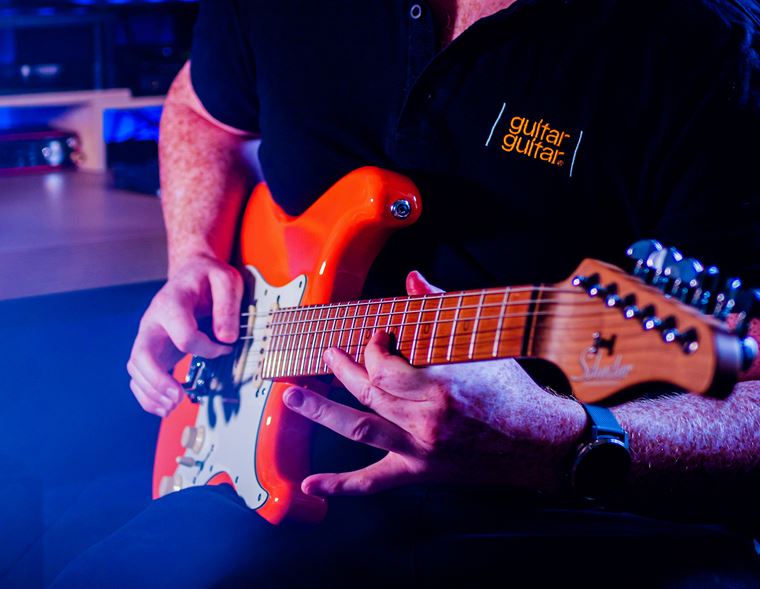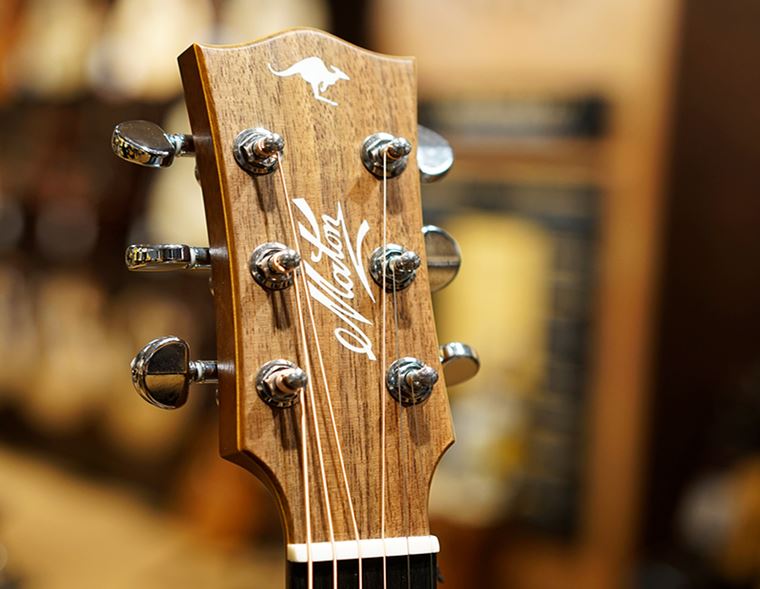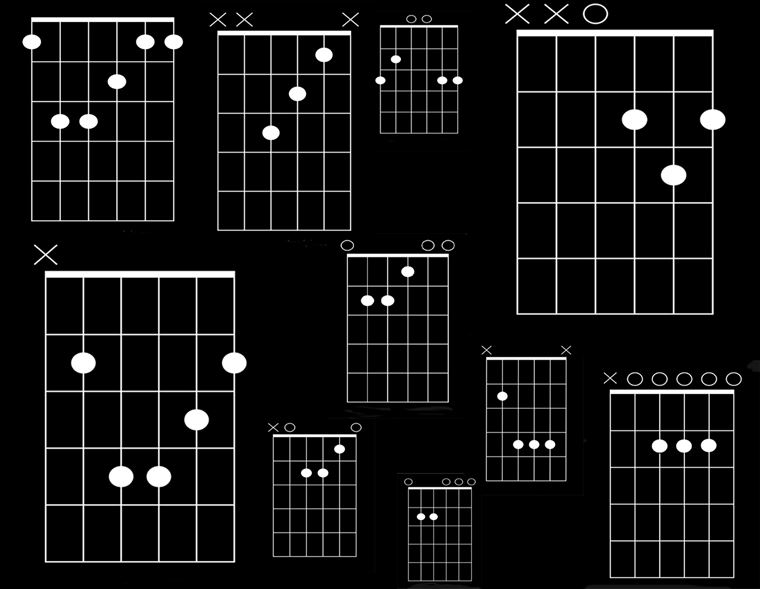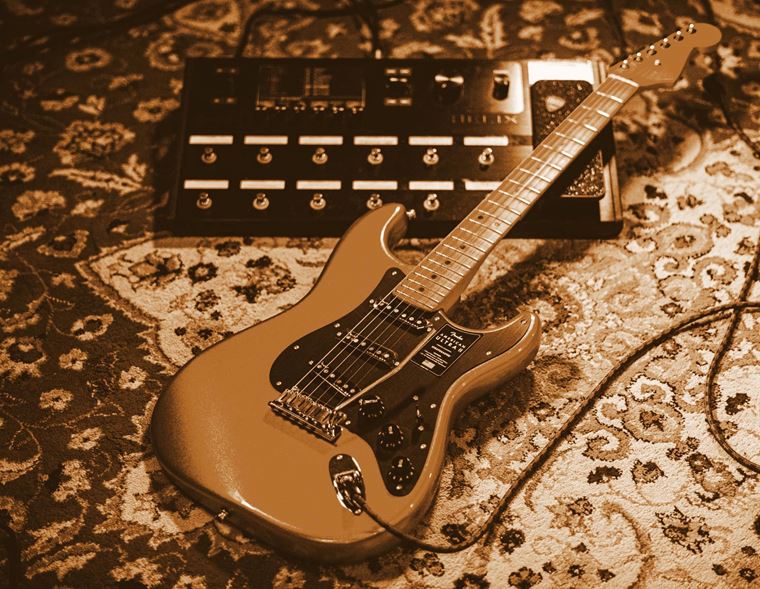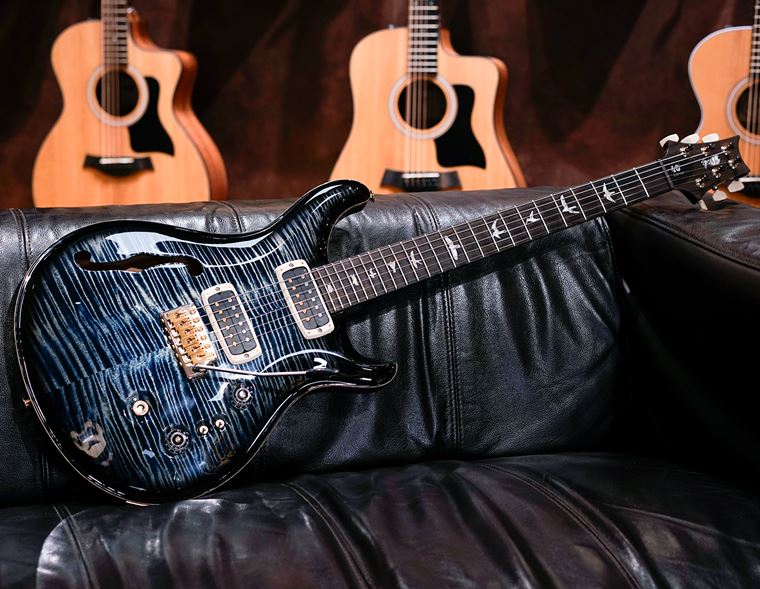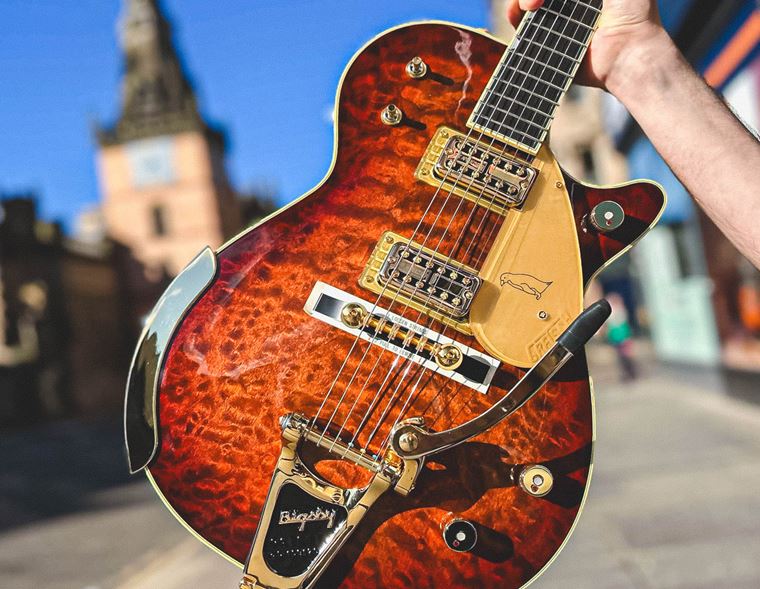Gibson Models Explained
Published on 12 August 2022
Gibson are one of the biggest and most famous guitar brands ever. Second only to Fender in terms of size, Gibson guitars are, for many players, the ultimate aspirational brand to own. Their timeless guitar designs are elegantly beautiful - not to mention highly copied - and the ‘Gibson sound’ has become an instantly recognisable descriptive shorthand for ‘thick, rich and sustaining tone’.

In the guitar market, most of the world’s instrument designs can be pretty accurately attributed to ‘Fender style’ or ‘Gibson style’, such is the towering influence of the two brands. In today’s blog, we aim to establish just what is meant by ‘Gibson style’, as well as looking at their main guitar designs. We’ll highlight the similarities across the brand, check out variations on the major styles, and identify each model’s unique differences. Along the way, we’ll raid the company vaults for some of the best Gibson pictures we have, and maybe even add some choice YouTube cuts of famous Gibson-playing artists, too. Ready to learn all about the different Gibson models? Grand. Let us begin…
‘Gibson Style’: Shared Features
So, as we mentioned, GIbson have a distinct way of doing things, and their way is different to that other guitar titan, Fender. Whilst there are always exceptions to these ‘blueprints’, they are rare indeed. Therefore, on coming across a Gibson guitar, one can reliably expect to find the following:
Mahogany
Mahogany is the timber used almost exclusively on Gibson electric guitars for the bodies and necks. Historical models often had maple necks, but today’s Gibson instruments are overwhelmingly made of mahogany. Why? Well, it is an excellent carrier of sound, with lots of character and resonance. It’s relatively easy to work with and is in plentiful supply. Mahogany grows quickly and is easily sustainable. For thick, complex, musical tones, it’s an excellent choice.
Glued Neck Joint
Again, some Gibson guitars in the past have had their necks bolted to their bodies for price-point reasons (it’s far cheaper to make a bolt-on neck, so some beginner models had bolts), but almost all Gibsons have glued in necks. This is one of the key reasons for the brand’s legendary sustain, along with the use of Mahogany. In addition to the tight, seamless bond created by the glue, each neck also has a ‘tenon’, which is an extended piece of wood the inserts into a corresponding whole made in the body. This helps the guitar act like a single piece of wood in terms of its resonant qualities.
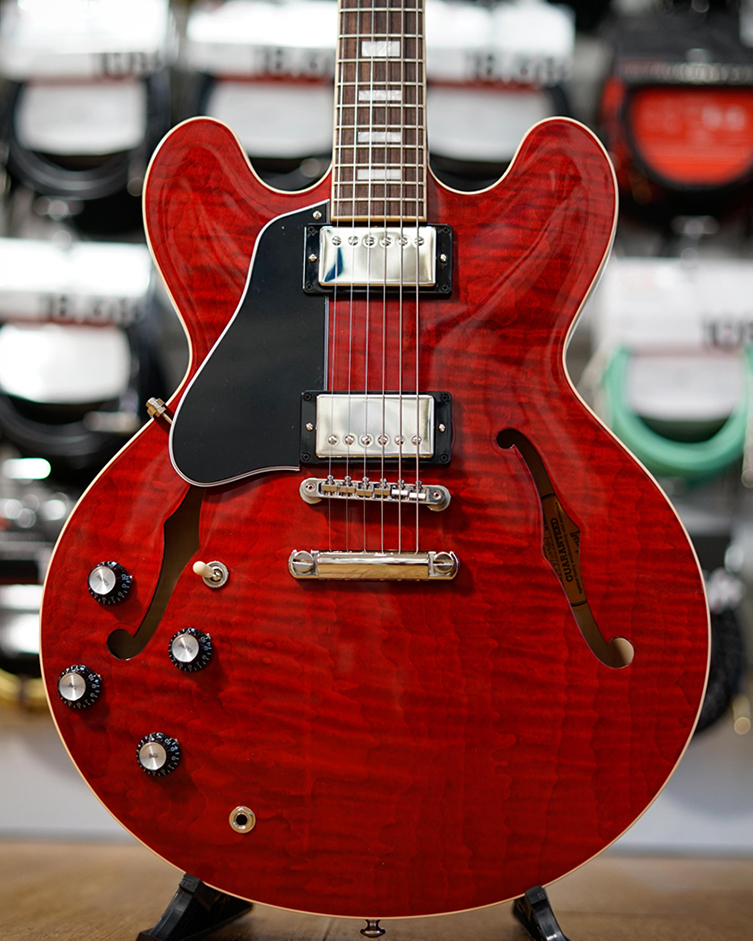
24.75” Scale Length
Known as the ‘Gibson scale’, each Gibson fingerboard is made to a measurement of 24.75” from the nut to the bridge. For context, the other major scale length used in electric guitar production is 25.5”, a mere three quarters of an inch longer. On paper, this doesn’t exactly seem like a big deal, but once you become accustomed to the feel of both lengths, your hands will really notice it! There is no better or worse value here, but most players would agree that the slightly shorter ‘Gibson scale’ makes the instrument easier to bend strings on since there is slightly less tension in the strings. Although many guitarists make frequent use of both styles, few of them are equally comfortable on both.
12” Fingerboard Radius
The radius of a fingerboard refers to how comparatively flat or curved it is. A lower value denotes a more curved fingerboard and a higher number flattens things out. Radii on electric guitars generally fall between 7.25” (vintage Fender guitars) and 16”-20” (modern high-performance guitars such as ESP, EVH and Jackson), so Gibson have relatively flat radius fingerboards.
Why is this significant? Again, it’s a matter of preference and taste, but many lead guitarists complain of their notes ‘choking out’ on more curved radius fingerboards due to the higher strings meeting the wood of the fingerboard curve as the player bends their notes. A flatter radius corrects this situation, so lots of lead players prefer this. The other side of the coin is that, at the low register areas of the guitar, open chords often feel more comfortable on a curvier board. It’s horses for course, but Gibson have stuck to the 12” radius forever.
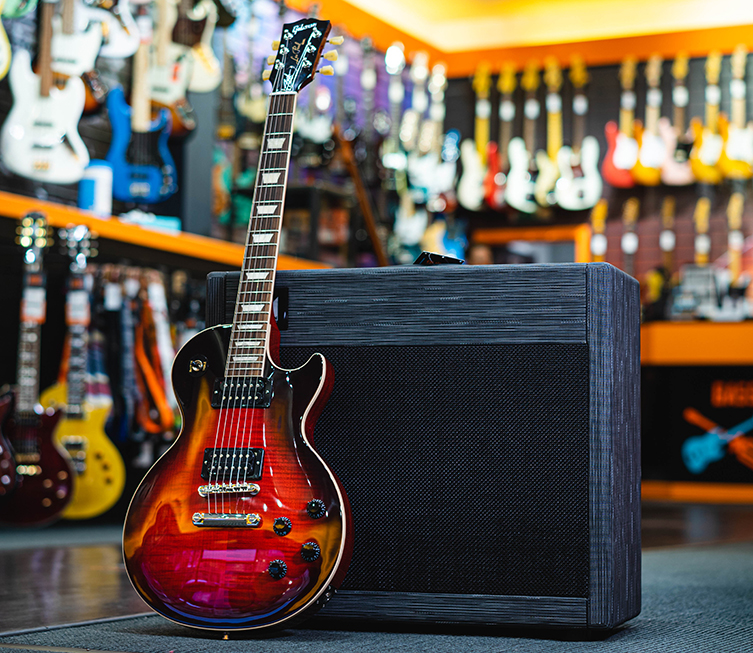
Nitrocellulose Finish
A ‘nitro’ finish, as the trade refers to it, is a thin and somewhat idiosyncratic coat of lacquer used by Gibson on all of their guitars. A nitro finish takes more skill to spray on, takes longer to dry and is dangerous to smell when being used, so it’s altogether more time-consuming and therefore expensive to make.
Why use it then? Well, it does have a very particular patina, and tends to ‘beautify’ over the years, so for looks, it’s a real win. Also, it has a lovely feel to the touch, and just evokes a sense of quality and luxury. Also, it’s traditional and, as you may have guessed, this is a big factor to lots of guitarists and aficionados alike.
Gibson Models Explained
Now it’s time to focus more closely on the main ‘shapes’ that Gibson produce. We’ll relate to Gibson’s current output with this blog since certain details may have changed back and forth over the years, but Gibson’s own output is largely based on historic models anyway, so this info should apply fairly liberally.
We’ll take in a brief summary of each model, and compare like with like as we go. This is not an exhaustive list, since models like the Les Paul have been made in almost countless variations over the years, making it impossible to be definitive. Again, we’ll talk about it using examples that are currently available, and refer to history when it’s appropriate.
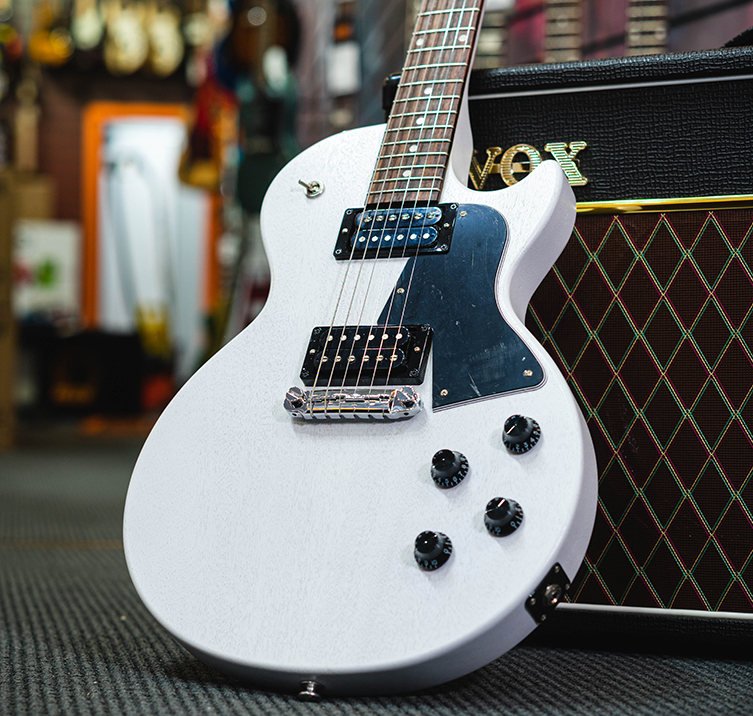
One important factor to note is the separation of most new Gibsons into two ‘collections’: the Original Collection and the Modern collection. These terms don’t relate to Custom Shop Gibsons, naturally enough, since the ‘customised’ notion of those guitars invites non-standard and non-specific features. Anyway, the Original Collection loosely bases its models on historical specs, so 50s model guitars will invariably have thicker neck profiles than 60s equivalents, and so on. Guitar bodies will generally not be ‘weight-relieved’ (sections of the body wood removed to make the guitar lighter) since that wasn’t standard practice in the golden eras of the 50s and 60s. This type of distinction is hardly unusual with heritage manufacturers and helps players to understand what they like by offering various permutations on a theme.
The Modern Collection, on the other hand, is allowed something of a freer hand in the design department, at least within the brand’s normal conventions. Weight relief is abundant here, as are advanced switching options, more contemporaneous finish options and other non-vintage features. They are still very much ‘Gibson guitars’, but do not follow any predetermined footprint put down by history. Which path you prefer in terms of aesthetics and performance is very much up to you, but it’s great that both routes exist!
Gibson Les Paul Guitars
It makes sense to begin with Gibson’s most popular model since pretty much everything prior to it’s release was some variety of hollow body jazz box, something that Gibson currently aren’t doing too much of. The rest of the history of Gibson, if you will, starts here so we will do likewise.
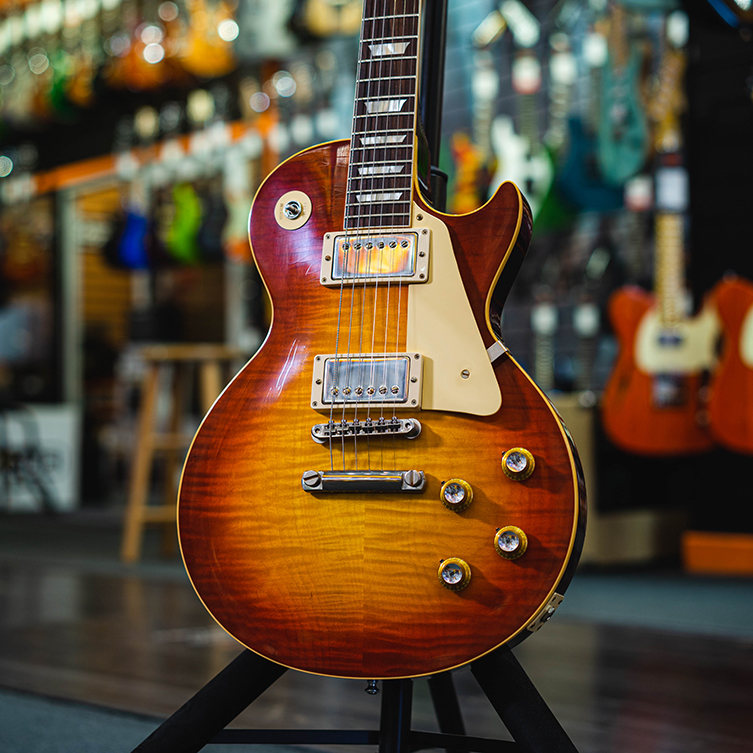
The Gibson Les Paul is the most successful signature guitar in the world. We don’t tendot think about it in those terms, but that’s what it is! Guitarist-inventor-personality Les Paul has many pioneering plaudits to his name, and this guitar is certainly the most visible of those. It’s a solid mahogany guitar with a single cutaway and (normally) a pair of humbuckers. The Les Paul is often what people are really talking about in regards to the ‘Gibson sound’, since its thick body helps produce a growl and sustain that brought the ‘heavy’ to rock music during the 60s British Invasion.
The Les Paul can be a pretty simple affair (Les Paul Tribute and Studio) or more deliberately decorative (Les Paul Custom), with the Les Paul Standard sitting somewhere between these two extremes. All of them will, to a greater or slightly lesser degree, dish out the famous Les Paul tone, though it’s amazing how tiny differences can matter in such a guitar.
Les Pauls in the Original Collection feature classic burst finishes, non weight-relieved bodies and moderate output humbuckers. These approximate the fabled ‘PAF’ pickups so beloved by tone-mongers, though the fact is, no two PAF pickups ever sounded alike, so opinions always differ on just what ‘PAF’ really sounds like. Generally, less output from the pickups allows a Les Paul to sound richer and more expressive. Original Collection Les Pauls are popular with players who love classic rock and blues, because they are very closely associated with the type of Les Pauls they’ve seen played by Jimmy Page, Peter Green and all the rest.
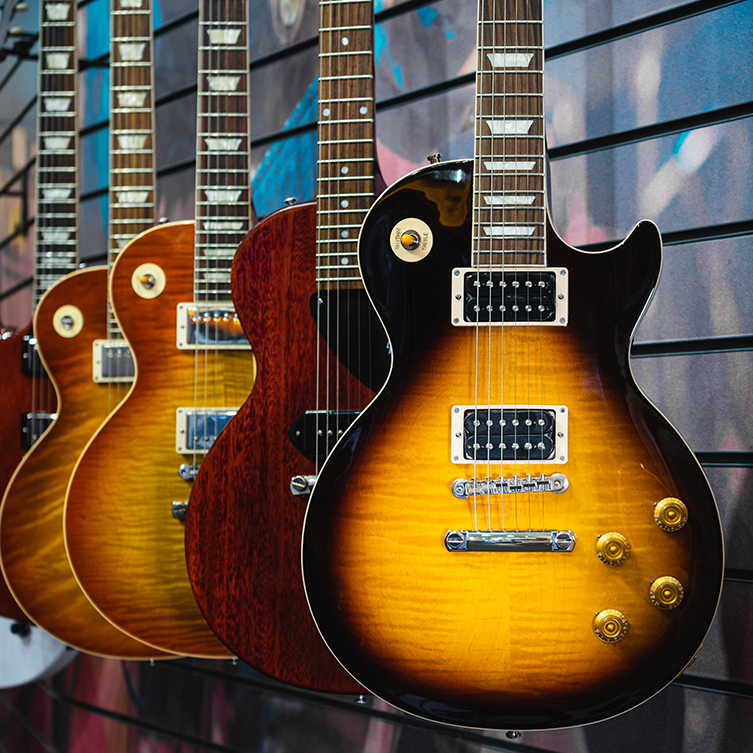
The Original Collection Les Pauls round up a little like this:
- 50s Les Paul Standard: P90 or Burstbucker 1&2 pickups (alnico II magnets, warmer sound), no weight relief, larger 50s profile neck, AA maple top.
- 60s Les Paul Standard: Burstbucker 61 pickups (alnico V magnets, brighter sound), no weight relief, slimmer 60s profile neck, AA top.
- 70s Les Paul Standard: Mini humbuckers, no weight relief, rounded C shape neck
- Les Paul Special: binding on fingerboard only, 2x P90 pickups, slab body, dot inlays
- Les Paul Junior: no binding, one P90 pickup, slab body, dot inlays.
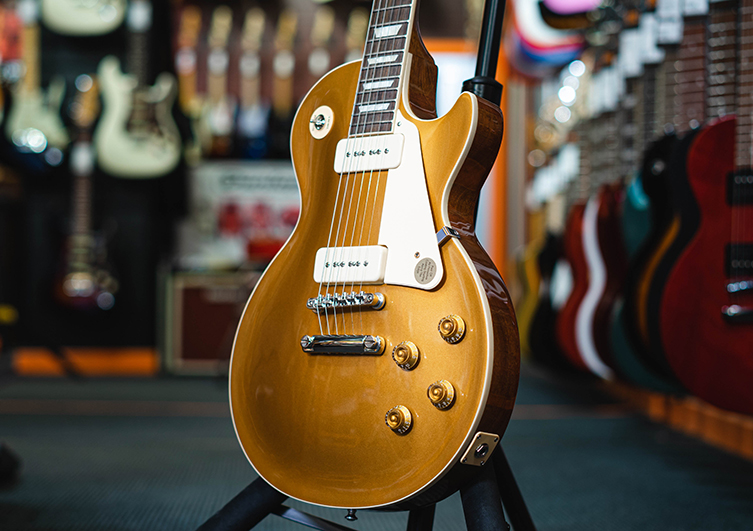
Les Pauls from the Modern Collection are where some slightly more liberal changes have been made to the recipe, usually in order to either offer a more affordable guitar, or to introduce features that traditionalists may not prefer to have. Again, the fact of having a choice is a pretty major win for all concerned.
The Modern collection contains the following Les Pauls, along with some brief differentials listed:
- Les Paul Modern: weight relieved, metallic finishes, extra switching options, Ebony fingerboard with compound radius (flattens out the further up the neck it travels), contoured heel.
- Classic: weight-relieved, slightly hotter sound, extra switching, classic finishes (though different options to the Standards),
- Studio: no binding at all, 490 & 498 model humbuckers (often used on Les Paul Customs), coil taps, different finish choices, plain top (no figured maple).
- Tribute: no binding, 490 pickups (different from 490 & 498 pair on the Studio), satin finish (though still nitrocellulose) , greater level of weight relief.
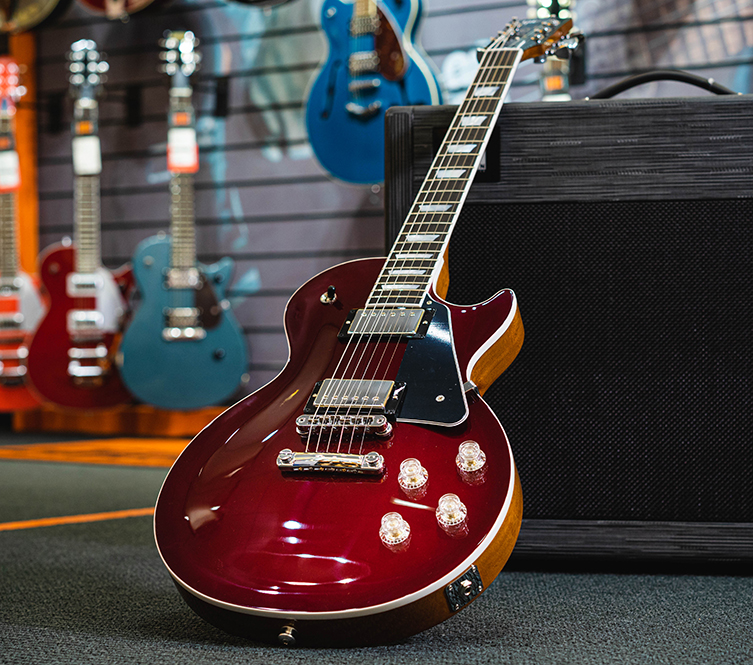
The above models all refer to guitars based on the Les Paul Standard blueprint. Gibson also make models based on the Les Paul Special and Juniors of the past. These are either single or double cutaway guitars with flat bodies (no carved top) and simplified controls. Decorations are a minimum and pickups are either one one two P90s - which is in keeping with history - or a pair of humbuckers. These guitars, though named Les Pauls, are actually quite a different experience in terms of sound, feel and look. They are great instruments in their own right and are valued equally by iconoclastic punks and conservative tone-freaks.
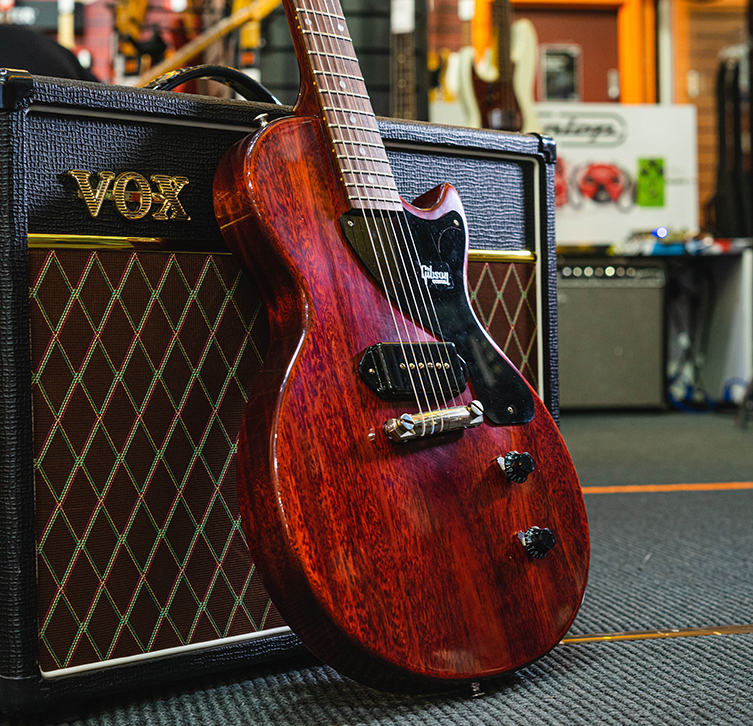
The other main type of Les Paul is the Custom, and it’s also one of the most revered. This is an old model from the 50s and has remained relatively unchanged since then. The most famous iteration of the black and gold ‘tuxedo’ model. Les Paul Customs are typically on the heavier side, weight-wise, and deliver a sound that’s both bigger and slightly darker than a Standard. Les Paul Customs have multiple layers of binding around the top, back, fingerboard and headstock. The headstock is a little larger than other Les Pauls and sports a ‘split diamond’ inlay taken from Gibson’s prestigious Super 400 Hollowbody. An Ebony fingerboard hosts large block inlays and the whole instrument is routinely described as one of the best looking in existence. This is built in Gibson’s Custom Shop facility, which we’ll come back to later on.
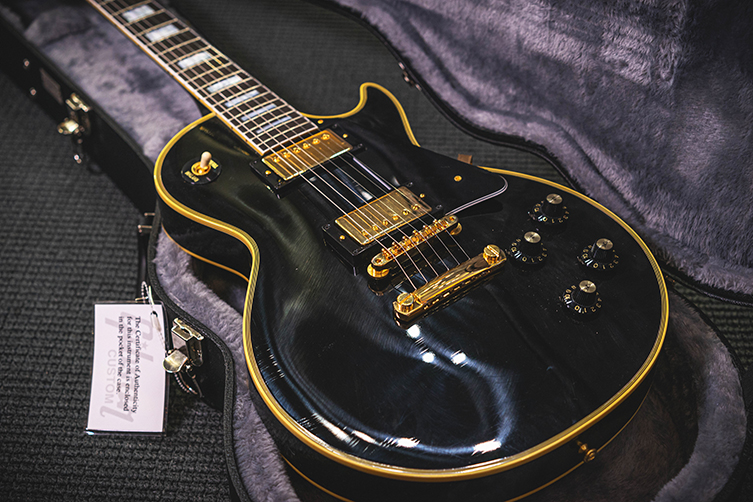
PAF Pickups
It’s with taking a second to talk about PAF pickups before we can any further, since they’ll continue to pop up throughout this guide!
Put simply, PAF pickups refer to the initial Patented-Applied-For pickup design that Seth Lover made for Gibson in the mid 50s. They effectively define what a humbucker is, but on top of that, their relatively (by today’s standards) underpowered sound actually makes them highly sought after. PAF humbuckers are not high output at all (DC resistance figures would put them at around 7-8.5k, compared to a fender single coil being around 6k and a hot Seymour Duncan humbucker being 16k!) and their low power allows for a large amount of player articulation - and therefore personality - to come through in the resulting tone. PAFs (call them ‘paff’ or spell out P-A-F, it doesn’t matter) sound sweet but still retain a growl beloved by all guitarists.
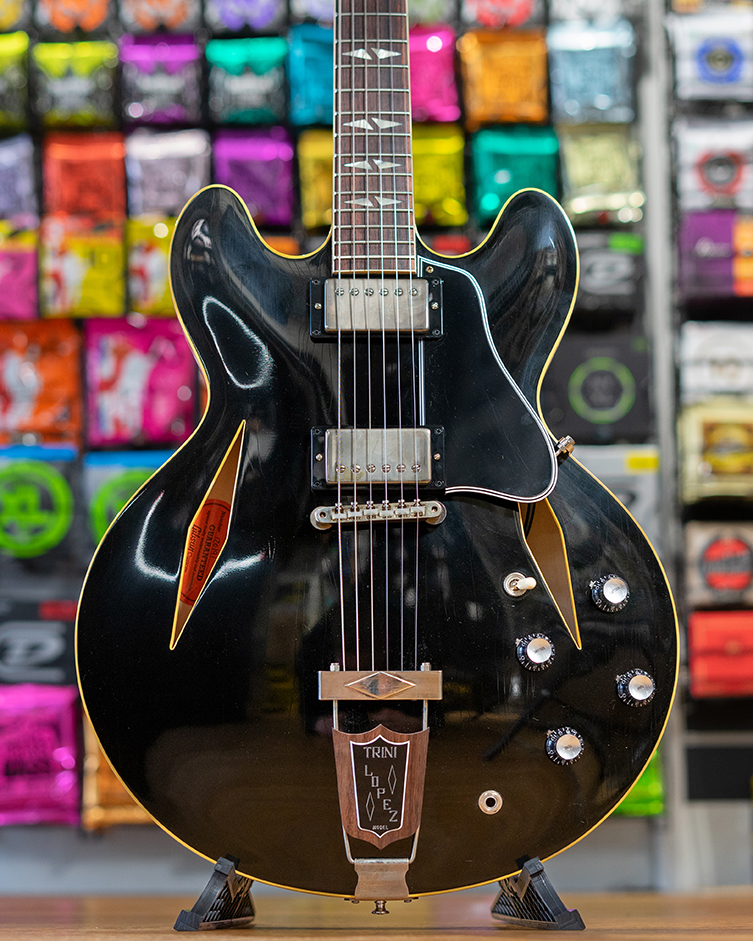
Gibson SG Guitars
The Gibson SG is universally known as the ‘one with the horns’ due to its ultra distinctive body shape. Between AC/DC’s Angus Young and Black Sabbath’s Tony Iommi using this style primarily, the SG has developed a reputation for being all about hard rock and heavy metal.
Like the Les Paul, the SG is eminently capable of such sounds and textures, but there’s a lot more to it than that. The SG (it just stands for ‘Solid Guitar’, prosaically enough) came around as the successor to the Les Paul in 1961. It was originally meant as a new signature model for Les Paul himself, who ultimately declined to use it. Undaunted, Gibson released it anyway and it’s now their second most popular guitar design ever.
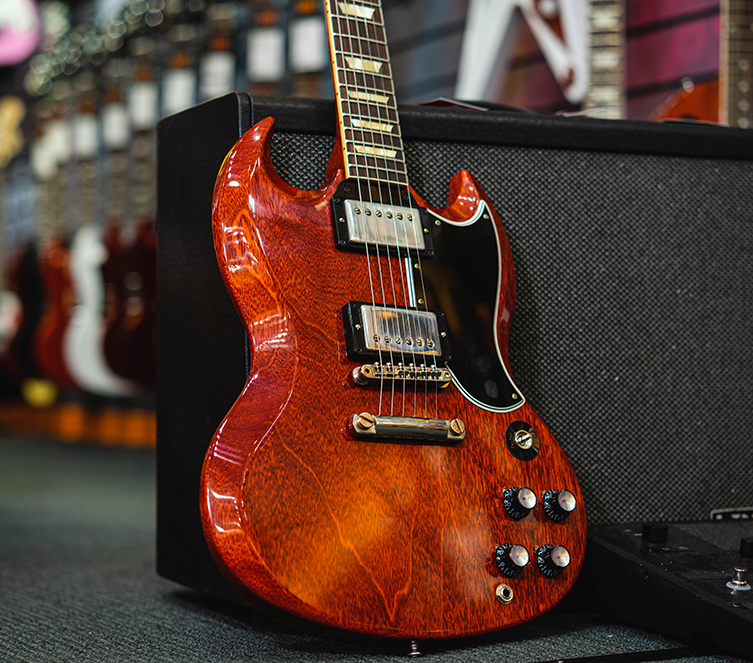
In basic terms, the SG is akin to a slimmed down Les Paul both physically and sonically. The body itself is thinner and flatter, lacking the LP’s carved maple top. This does translate to the tone, which still packs a punch but doesn’t have the amount of sheer low end available on a Les Paul. Instead, the SG ‘cuts’ a little more, and perhaps wins out in the clean tone department. Again, it’s all subjective! Plenty of hard rockers love the SG, as we’ve said, but you’ll see blues players using them, funk players and indie rockers, too. The Gibson SG fits into many musical situations with ease!
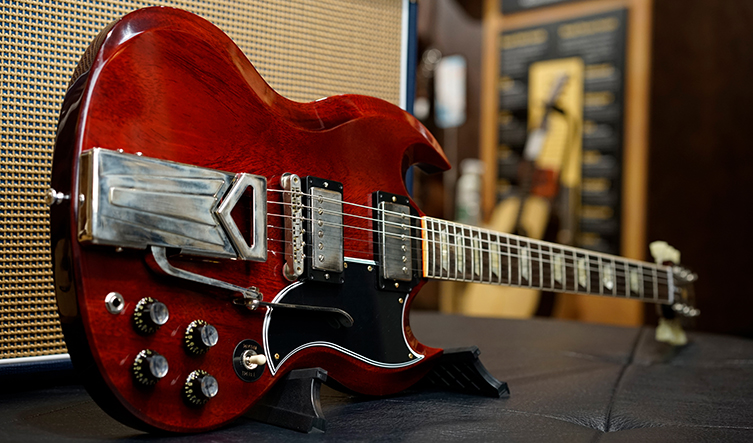
In terms of the ranges available, it’s much the same story as with the Les Paul in terms of the model being spread between the Original and Modern Collections, but the allocations, if you will, are somewhat different this time out. The SG Standard, for example, belongs in the Modern Collection (the LP Standard is firmly in the Original Collection by comparison) and its Original equivalent is the ‘61 SG. This makes sense to us, but since it might not necessarily translate, here’s a brief rundown of what to expect from each collection:
Original Collection SG Models
- 61 SG: Available with stop tailpiece or two varieties of vibrola tremolo, slim taper neck with binding and trapezoid inlays, smaller pickguard and a set of 61T & R pickups.
- SG Special: Two P90 pickups, wraparound bridge/tailpiece, dot inlays on a bound rosewood neck. Available in classic translucent and metallic colours.
- SG Junior: Single bridge position P90 pickup, wraparound bridge/tailpiece, unbound slim taper neck with dot inlays.
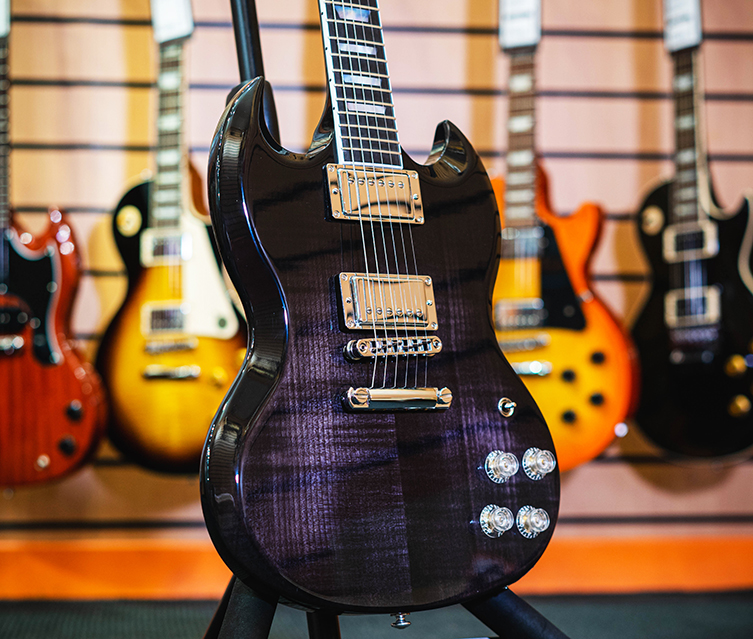
Modern Collection SG Models
- SG Standard: Rounded neck profile, trapezoid inlays, 490R & T Alnico II pickups, large ‘batwing’ pickguard, neck binding.
- SG Modern: AA flame maple top, 24 fret ebony fingerboard with compound radius, asymmetrical neck profile, alnico V pickups with switching options.
- SG Tribute: Satin finish, rounded neck profile, 490 R & T pickups (same as SG Standard model), larger pickguard, dot inlays and no binding.
Players who use SGs tend to like them for their lighter weight, adaptable sound and good upper fret access. Les Pauls are heavier in every way, but otherwise, the styles are pretty similar.
Gibson ES Guitars
Here’s where we’ll speak of the most well-known ‘f-hole’ guitars in the land, the Gibson ES range. The differences between ES models are often minimal, and indeed have changed throughout the years, so again, this article refers to what’s currently being made. For example, today’s ES-345 guitar is a normal ‘mono’ guitar (like all other electrics) but a stereo version - with two outputs - has been created at various points in the past.
The ‘ES’ part of the title simply means ‘Electric Spanish’, apparently to distinguish them from the likes of lap steel guitars which were popular in 1958 when this range debuted. It seems a little unnecessary to us (who’d ever mix the two up?), but that’s the official line on the name! They are the world’s most famous semi-acoustic guitars, and that’s another term that invites confusion. These are not really ‘acoustic’ in any appreciable way more than, say, a Les Paul. They are full-on electric guitars but they do have hollow sections inside their bodies, and these are made obvious by the use of f-holes on the body’s top.
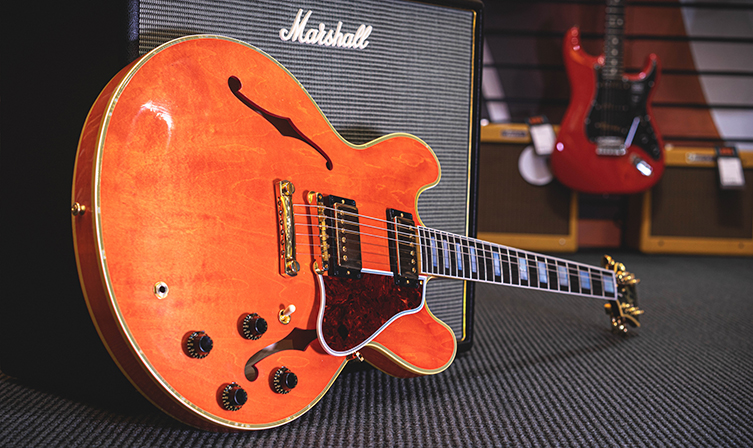
Does this affect the sound? It sure does, but it’s perhaps more subtle than you might think. The semi-hollow nature of the design (a thick chunk of solid timber runs down the centre of most of these models, so they are close to being solid in many respects) gives notes a slightly later ‘bloom’ than the direct signal you’d expect from a Les Paul or SG. It’s a very resonant instrument, with overtones that can turn to feedback more easily than with a solid Gibson model. They do tend to have a little less sustain too, but that can be a factor of volume and player position as much as a quality inherent in the guitar itself, so that’s worth bearing in mind. Gibson ES guitars are well known for being warm sounding and versatile, so you’ll see players of many genres using these, though perhaps not so much in the hard rock and metal world (exceptions exist of course, as they do in every case!).
Today, we’ll look at the main ES models, how they are similar and how they differ from one another. Since Gibson do not make many of their larger bodied ‘jazz boxes’ at the moment, we’ll stick to the more slimline models for this guide.
Gibson ES-335
The most well known and played model in this range is the ES-335. Referred to as either the ‘three thirty five’ or the ‘three three five’ (both are fine), this guitar was introduced in 1958 and its name comes from its initial price of $335. Blues and jazz fans particularly love the 335 as its warm tones make for a very pleasing ‘lead’ voice with either a clean or lightly overdriven tone. Whilst Gibson occasionally (as they do right now) offer a 335 with P90 pickups, the overwhelming majority of them have humbuckers, and of a distinctly PAF-sounding variety.
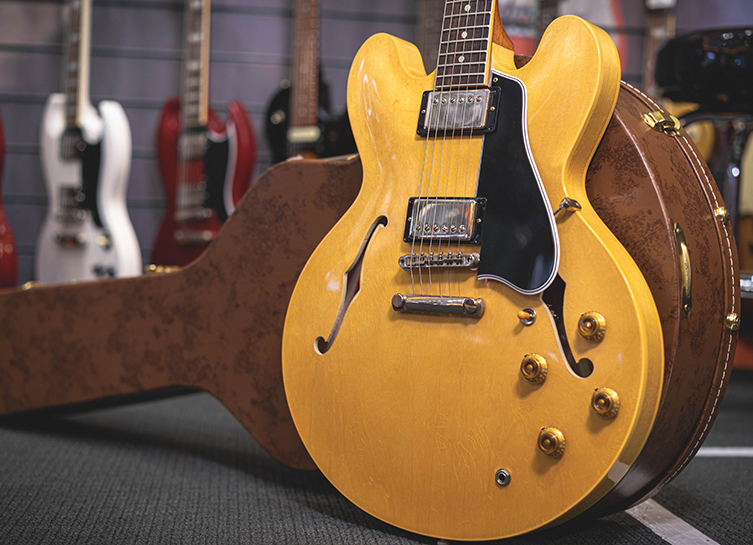
335’s sometimes have small block inlays but most have dots and this has earned them the ‘dot’ nickname that Epiphone used for decades too. Construction is actually layers of maple and poplar ply over that solid maple centre block. This is always how it has been done and the amount of manual labour involved in building one is significant, which explains their comparatively higher cost. Gibson currently offers a model with a figured Maple veneer on top (the ES-335 Figured) but otherwise, we refer to them, as we do with Les Pauls, as ‘plaintops’.
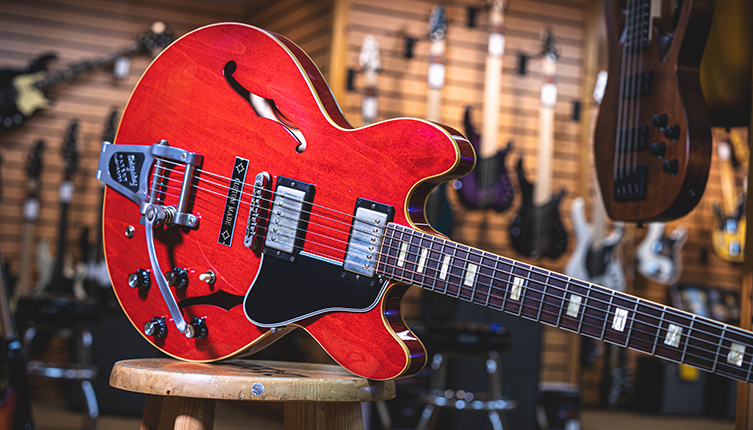
Gibson ES-345
The ES-345 is currently a cosmetic upgrade on the slightly less fancy 335. In times past, ES-345s used to have stereo outputs (it never really took off) and a dial at the controls called a ‘varitone’ switch, which incrementally filtered out sections of the guitar’s low end as you turned the dial. These features have not currently survived to Gibson’s current ES-345, which does sport the extra body binding and parallelogram fingerboard inlays of historical models.
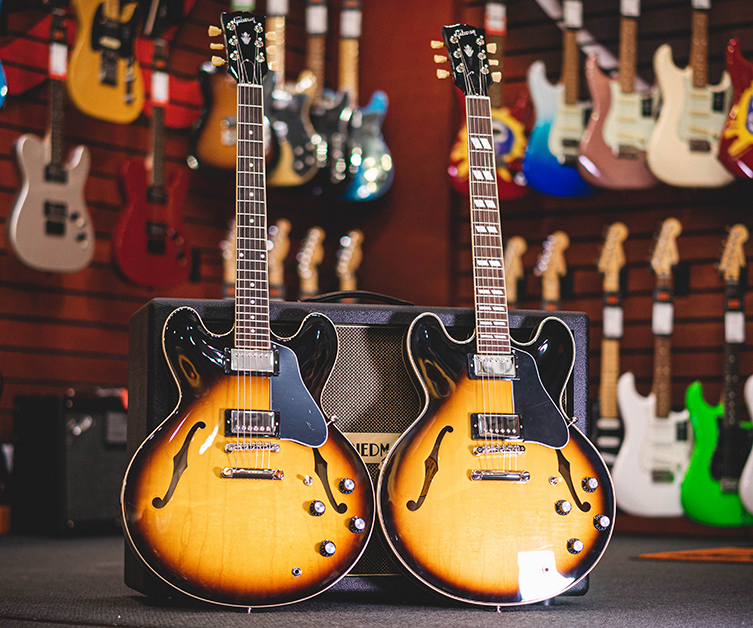
Gibson ES-355
The most decorative of the ES thinline models, the Gibson ES-335 is in many ways the equivalent to the Les Paul Custom in terms of its visual motifs. Picture a 335 but then add the extra multi-ply binding, block inlays and split diamond headstock inlay. The result is one of Gibson’s best designs dressed up to become one of Gibson’s best lookers. Ebony fingerboard and gold hardware? Check! This is a prestigious guitar amongst others in a prestigious brand, and is currently made by the Gibson Custom Shop.
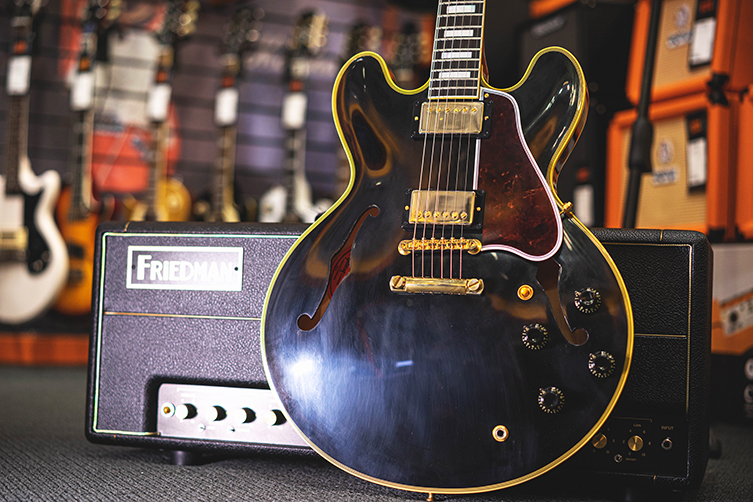
Gibson ES-339
For years, many players who would otherwise love to use an ES guitar such as the 335 or 345 didn’t do so due to their size. Whilst not huge compared to the likes of an ES-175, these instruments still presented a practical problem. They just had big, wide bodies and some guitarists had trouble with them, especially when sitting down.
If only there was a 335 that was a similar size to the Les Paul. Wouldn’t that be perfect?

The ES-339 fits perfectly into Gibson’s history-friendly range, but it’s actually less than two decades old. It was designed expressly to be a shrunken 335 and is made in exactly the same way, with a3-ply body and solid centre block. The current model sports a pair of 57 Classic pickups, which are directly based on vintage PAF units.
Gibson ES-330
The Gibson ES-330 is the one model in this range that goes about business in a different manner. From the outside, you can see that the design is already a little different. The neck sits further into the body, for one thing and the pickups are a set of P90s rather than the customary humbucker pickups.
Inside the body though, is where the real difference lies. Unlike the other ES models we’ve seen today, the ES-330 is in fact completely hollow. This lends the guitar a completely different tonal character: there is a percussive, ringing quality to this model that makes it very popular for rhythm players and songwriters. Also, through a clean amp, this guitar imparts an almost Strat-like quality to expressive leads, making it something of a ‘secret weapon’ for those in the know!
Gibson ES-175 & ES-295
Though these two beautiful models are not currently being made by Gibson, we felt that they were too significant to omit! The ES175 is Gibson’s most well-known hollow body ‘jazz box’, and is often seen in the amrs of players such as Yes’ Steve Howe. It has a deep body, no centre block and a ‘florentine’-style cutaway (the other blunter type is called ‘Venetian’) which makes it a distinctly beautiful guitar.
The ES295 is effectively a ‘goldtop’ variant of the ES175. Both are from the early fifties and both are considered monumental classics. The ES175 is often seen with PAF humbuckers (but not always!) whereas the ES295 is almost always made with a pair of P90 pickups.
Gibson Designer Guitars
Gibson have stuck to their ‘Designer’ term for decades. It refers to any of their patented ‘shape’ guitars that cannot be reasonably claimed by the Les Paul, SG or ES camps. At the time they were first released, these guitars were considered pretty outrageous, but nowadays they are well-loved timeless classics. Let’s check them out…
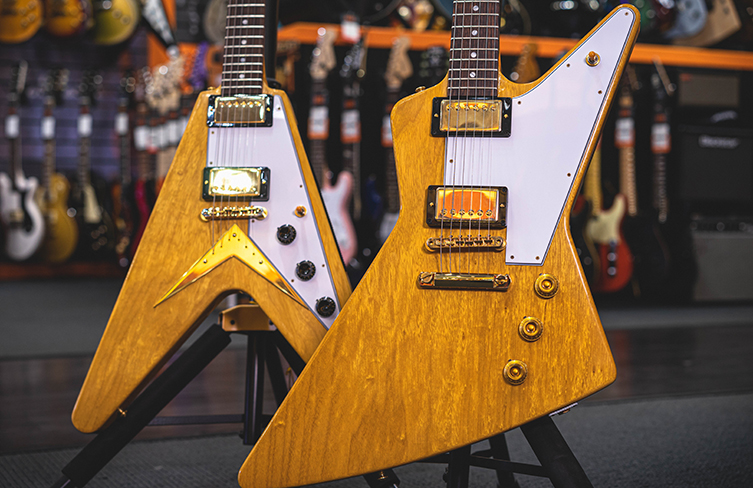
Gibson Flying V Guitars
The Gibson Flying V is, after the Stratocaster, perhaps the most recognised shape for ‘electric guitar’ in the world. In terms of iconography, any cartoon character, neon sign or heraldic t-shirt print bearing the vague outline of a Flying V will be instantly recognised and understood, the world over. That’s iconic.
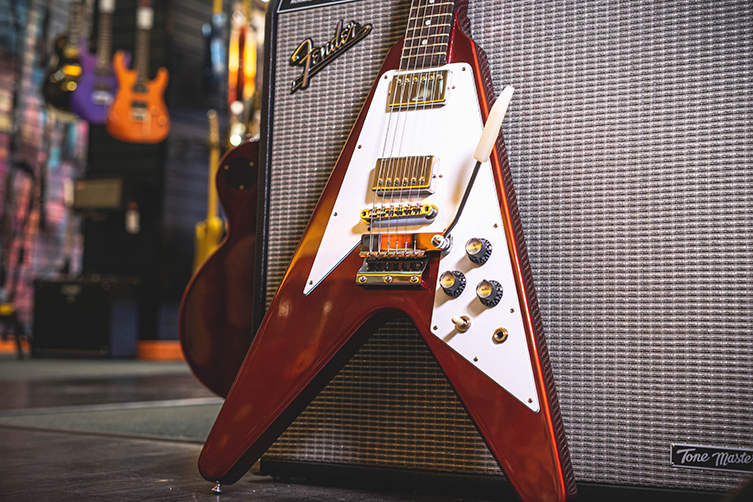
The V was released in 1958 as part of the ‘Moderne’ series of guitars, and in reality, it hasn’t changed much since then at all. Like the SG, you can find models with larger or smaller pickguards, but the shape itself is so well-defined, there’s little room for variations beyond what Gibson normally offer in terms of decoration.
The Flying V, contrary to popular opinion, is actually quite comfortable to sit down with. Simply place the points of the V at either side of your right leg and a perfectly playable ‘classical’ position is achieved, so don’t let that put you off one of the most iconic guitar designs around!
Flying V models tend to adhere to the Gibson ‘House style’ of using two humbuckers, a tune-o-matic bridge and a hard tailpiece. The design screams hard rock, of course, and in this the Flying V excels, but the voice is largely similar to the SG, making it a sonically versatile instrument.
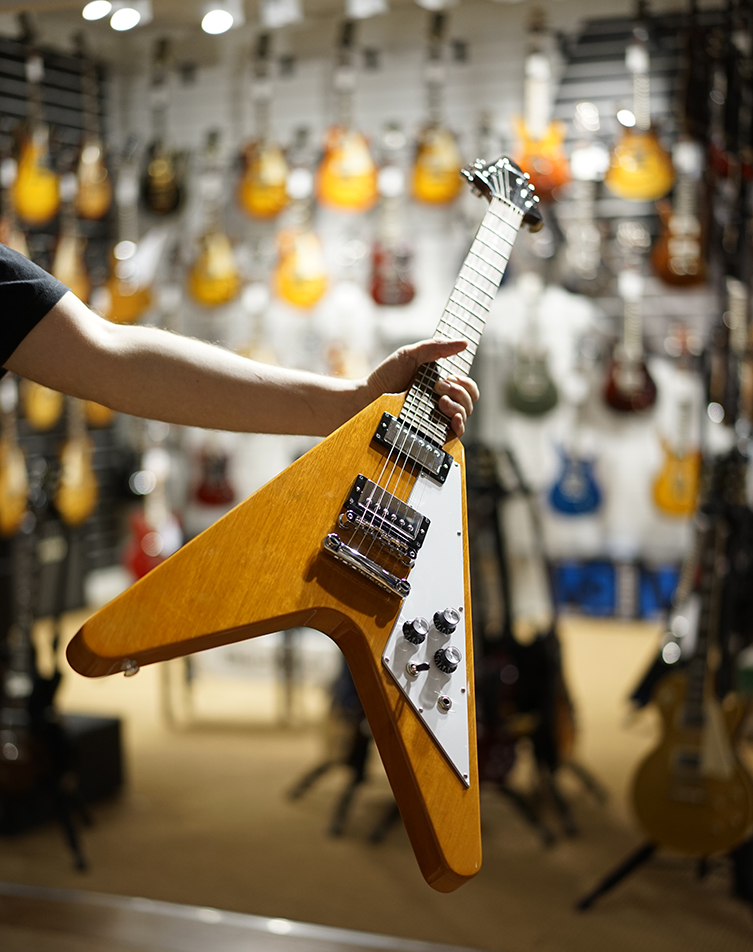
Gibson Explorer Guitars
Another member of the ‘Moderne’ series (along with the Moderne itself, which didn’t last the test of time and is now a particularly rare beast), the Gibson Explorer has, like it’s sister the Flying V become synonymous with hard rock, thanks to its adoption by the likes of Metallica and Mastodon.
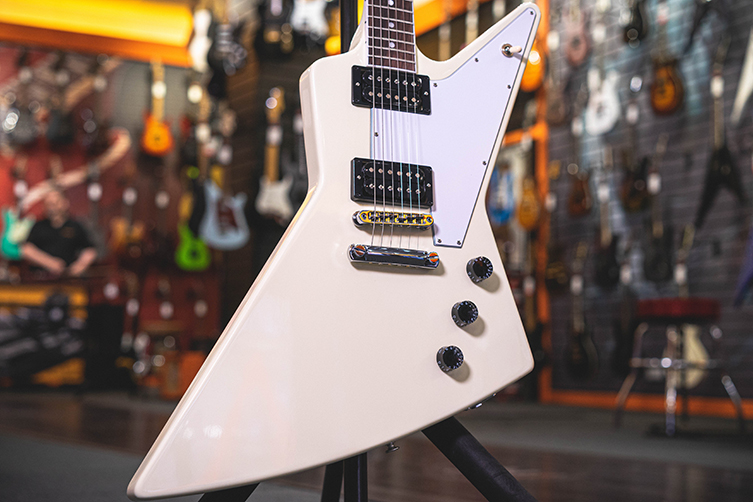
The Explorer looks like it’ll be an awkward object to negotiate, but put a strap on it and you’ll quickly find it to be one of the most comfortable and well-balanced guitars on the market. The large mahogany body and set neck make this a sonically weighty instrument indeed. Superficially, the Explorer has the same properties as the Flying V (and many Gibson designs), so the key in determining if it’s for you is by simply playing it. This goes for all of the ‘Designer’ Gibsons, since it’s the body shapes that differentiate them the most. Traditionally made with Korina (or White Limba, it’s the same thing), today’s examples are made with Mahogany (Korina sounds very, very similar) and sport a pair of Burst Bucker pickups. 70s reissue variants are available too and have the famous ‘Slim Taper’ neck (not really all that slim by today’s standards) and 70s ‘Tribute’ pickups for a raw growl worthy of the best rockers.
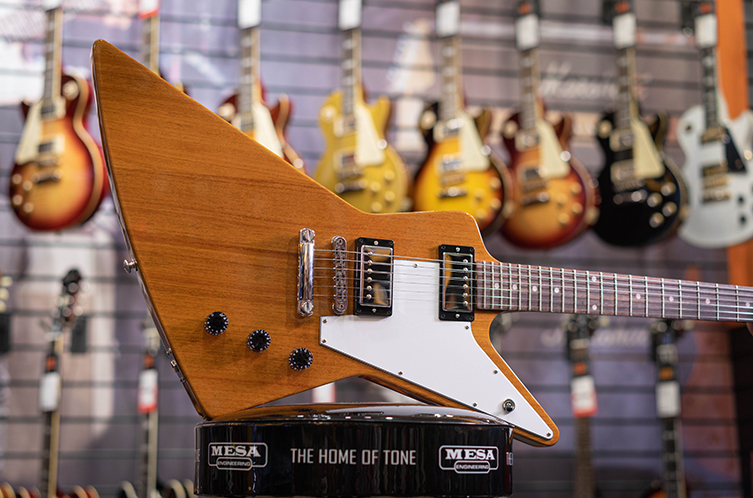
From early U2 to Halestorm, the Explorer is a totem of rock stardom.
Gibson Firebird Guitars
To reverse or not to reverse? This is a problem unique to the Gibson Firebird. How many other guitar shapes are offered with a corresponding ‘backwards’ option? It’s not quite that cut-and-dried, but this charismatic guitar has a long history of being available as a ‘reverse’ (the original design, bafflingly) and a ‘non-reverse’ model with some of the body contours redrawn and the headstock, yes, reversed!

The easiest way to tell if a Firebird is ‘reverse’ or not is to look at the headstock. Reverse models feature the tuners along the bottom as opposed to the top on the non-reverse models. Looking at the body, the reverse models have a longer lower bout, but the non-reverse Firebirds have - you guessed it - the larger section on the upper bout.
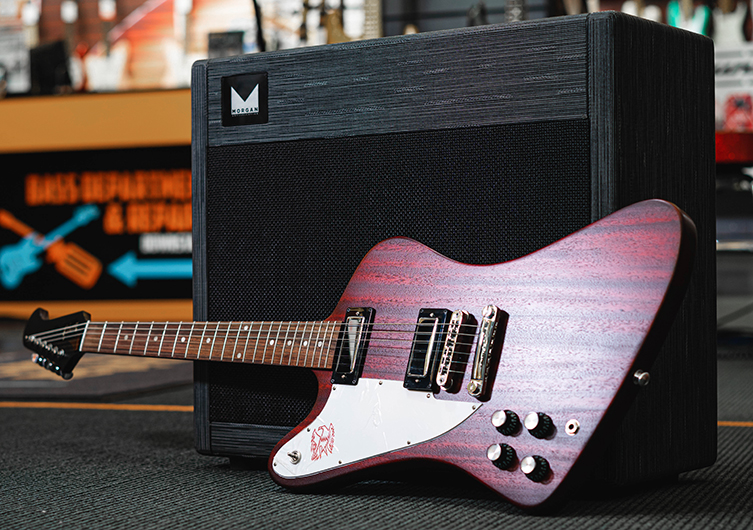
None of this plays too much into the sound of the guitar, though the feel of the strings is somewhat changed by the additional string travel on the reverse model a la Jimi Hendrix’s guitars. Historically, Firebirds have seen quite a few iterations, with P90s, humbuckers, mini humbuckers, 2 pickups and 3 pickups. As with all Gibson guitars, Bigsby tremolos are occasionally present, and mahogany is the prevailing wood.
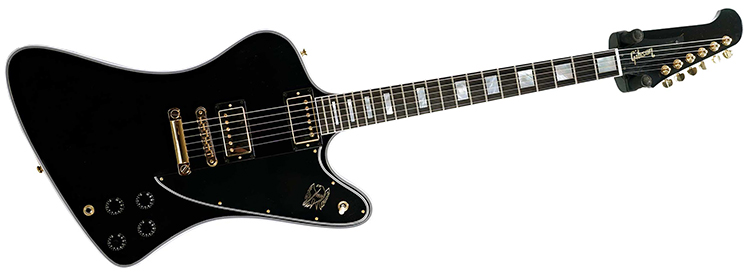
What’s often (but not always) different is the neck join. On the Firebird (and its bass sibling, the Thunderbird), Gibson use a ‘through neck’ construction. The neck travels through the entire length of the instrument, body and all, and is then completed by wooden ‘wings’ being attached to finish the sides of the body. Often, the neck part is made from multiple pieces of timber sandwiched together for extra strength. Resonance is massive, sustain is great, and when there’s a translucent finish in the body, you can enjoy the cool look of the multiple woods too.
For players who enjoy the rich gibson tone but don’t want to play their most popular shapes, these designer models serve up a full-fat meal of thick, chewy tone whilst also making a statement in the visual department!
Gibson Custom Shop Guitars
Lastly for today, we’ll look briefly at Gibson’s Custom Shop, since they are a department that make good use of all of Gibson’s iconic shapes and designs.
The Custom Shop is a small team of Gibson’s top builders, who dedicate their time, sweat and sanity to recreating intensely accurate replicas of vintage Gibson guitars. Perhaps even more so than Fender, Gibson has a history that is written in mystical terms, so the Custom Shop artisans go to considerate lengths to recreate not just woods and pickup winds, but correct plastics and glues to ensure that what they build is as close to historical examples as is possible.
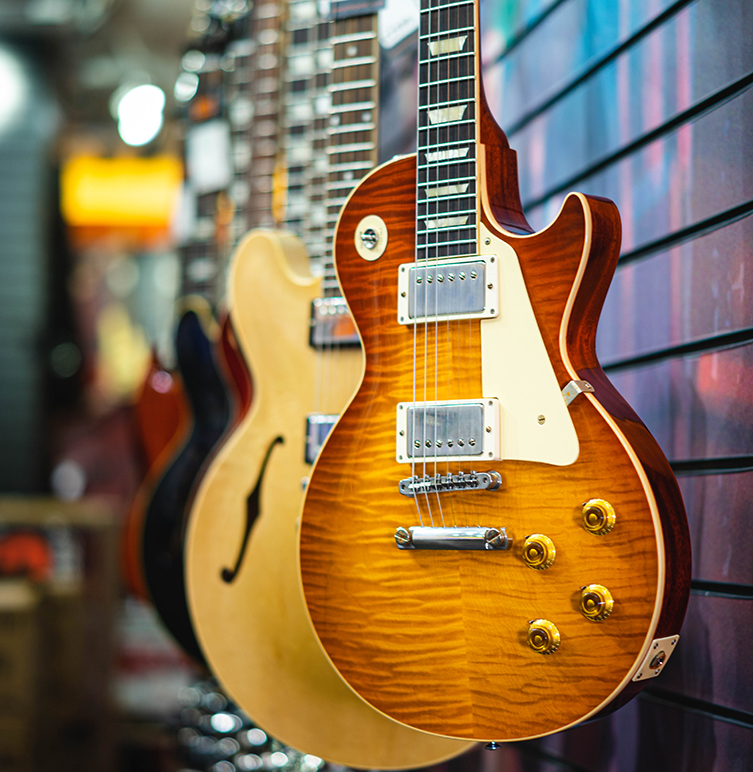
The Gibson Murphy Lab is a subdivision of the custom shop. Led by Tom Murphy, this team are specialists in ageing these Gibson Custom Shop guitars. These are meticulous, sympathetic signs of wear and tear, realistically realised in order to fully complete the ‘vintage replica’ goal. Obviously, it’s only vintage reissue instruments that pass through the hands of the Murphy Lab (Gibson’s Custom Shop make modern instruments as well as classic replicas) and the level of ageing is divided into three incrementally more worn values from Ultra Light Aged to Ultra Heavy Aged. For Gibson fans, this is the best of the best.
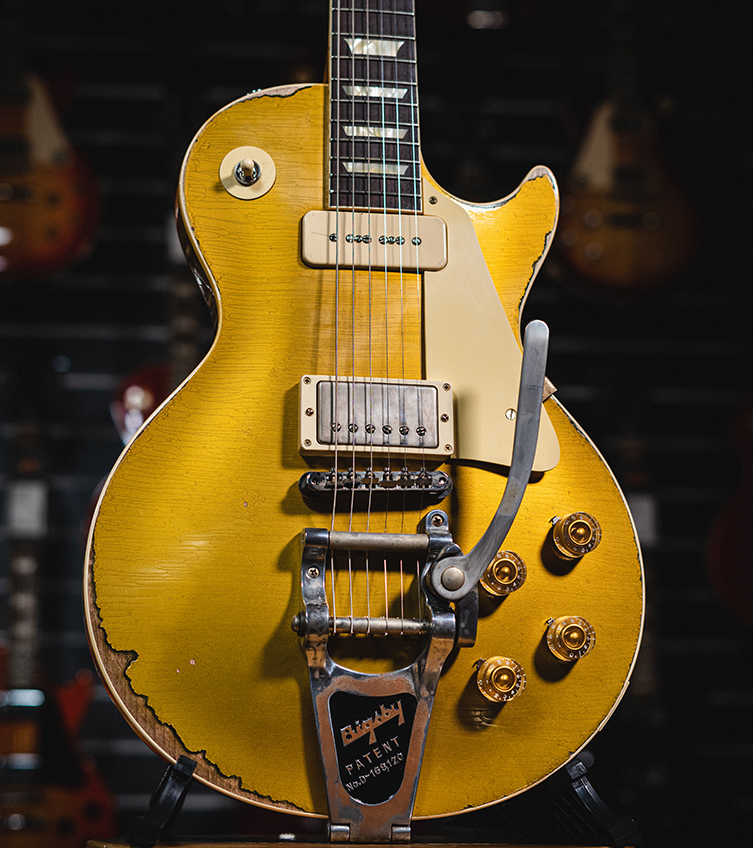
A Brief Bite of a Very Large Pie
Even though this article ended up being pretty long, it’s still only a taster menu of what’s out there. As stated before, we don’t have the space to really delve into all of the variants available right now, far less in the past! Suffice to say that this is a primer for people who want to go further down the path of knowledge of their own. We hope this has been a useful guide to you, and remember, our staff in every store are ready and willing to lead you further into the wonderful world of Gibson guitars!




